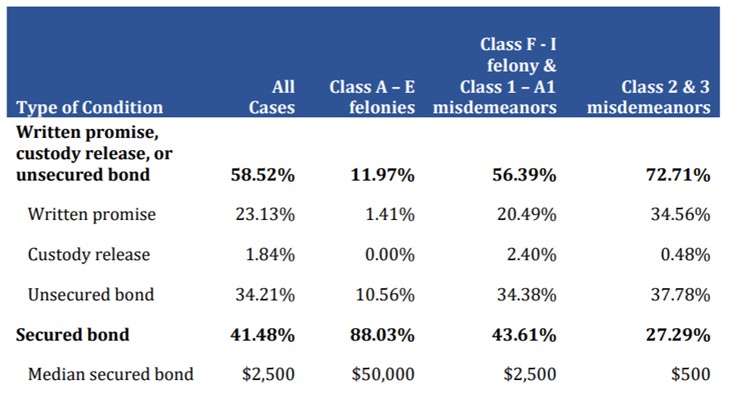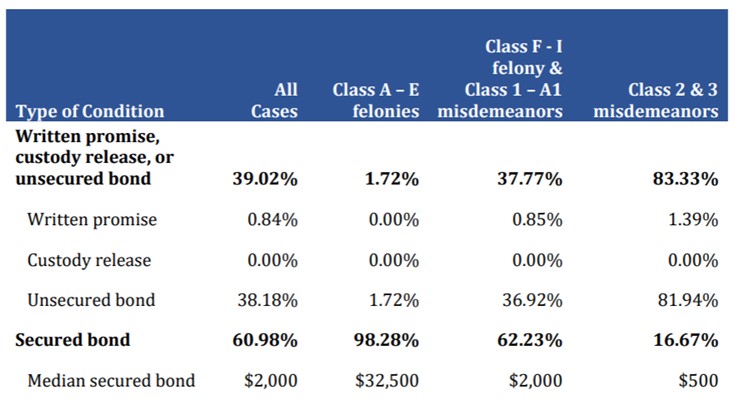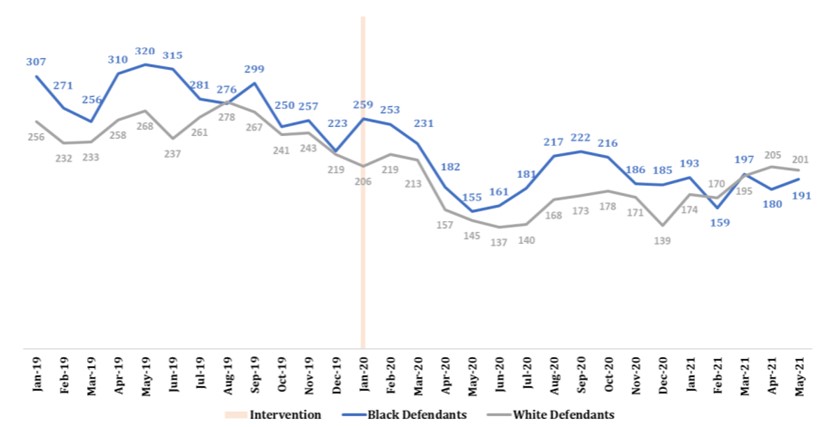Interim Report: Judicial District 21 Bail Project
In January 2020, North Carolina’s Twenty-First Judicial District (Forsyth County) implemented a consensus bail reform initiative in the form of a structured decision-making tool for magistrates and judges when making bail decisions. Some key features of the tool include:
- creating a presumption for a condition other than a secured bond for Class 2 and 3 misdemeanors;
- providing screening factors to identify individuals charged with Class 1 and A1 misdemeanors and Class F-I felonies who can safety be released pretrial;
- affording no special presumption or screening for those charged with Class A-E felonies; and
- embedding within the decision-making process the statutory requirement that conditions other than a secured bond must be imposed absent a risk of non-appearance, injury to any person, or interference with the criminal proceeding.
The new decision-making tool was developed by a stakeholder team that included judges, prosecutors, public defenders, clerks, magistrates, law enforcement leaders, and others. One of the working group’s primary goals was to reduce pretrial detentions of individuals who do not pose a pretrial risk but are detained solely due to inability to pay bail. The UNC School of Government Criminal Justice Innovation Lab supported stakeholders in the development and implementation of the new tool and, with support from local stakeholders, is conducting an empirical evaluation of its impact. We recently released a report (here) from the first year of the evaluation. This post summarizes key findings.
Magistrates imposed conditions other than a secured bond in the majority of cases.
After implementation of reforms, magistrates imposed a written promise, custody release, or unsecured bond in 58.52% of all cases. For Class 2 and 3 misdemeanors, which were the target of the reforms, they imposed a condition other than a secured bond in 72.71% of cases. Table 1 below shows the distribution of conditions set by magistrates by offense category. As expected, as the severity of the offense increased, the likelihood of receiving a secured bond increased, as did median bond amounts.
Table 1: Percent conditions of release by highest offense class in magistrate bail forms, July 1, 2020 to June 30, 2021–bond doubling cases removed
Judges imposed conditions other than a secured bond in the majority of target cases.
If the new tool is working as expected, more individuals who are likely to succeed pretrial are being screened by magistrates for conditions other than a secured bond, leaving more people who are less likely to succeed pretrial in the pool of individuals seen by a judge at first appearance. We thus expected to find that judges would impose conditions other than secured bond at a lower rate than magistrates. The data show that this occurred, at least when examining this metric as to all cases. Specifically, judges imposed conditions other than a secured bond in 39.02% of all cases, a rate that was lower than that for magistrates (58.52%). However, for Class 2 and 3 misdemeanors, which were the target of these reforms, judges imposed conditions other than a secured bond at a higher rate than magistrates (83.33% of cases for judges; 72.71% for magistrates). Table 2 below shows the distribution of conditions of release set by judges by offense category.
Table 2: Percent conditions of release by highest offense class in judge bail forms, July 1, 2020 to June 30, 2021
The new decision-making tool is advancing the District’s equity goals
In bail decisions set by magistrates, initial analyses showed that there were no statistically significant differences in the likelihood of receiving a secured bond between cases involving Black individuals and those involving White individuals for Class 2 or 3 misdemeanors or Class A-E felonies. By contrast, initial analyses showed that intermediate-level cases involving Black individuals were more likely to receive a secured bond than cases involving White individuals. However, we conducted additional analyses and found that this difference was not statistically significant when we accounted for case-specific factors, such as prior conviction and history of failure to appear.
In bail decisions set by judges, cases involving Black and White individuals were equally likely to result in a secured bond for all offense categories.
Implementation of the bail decision-making tool is strong
The decision-making tool preserves judicial officials’ discretion to deviate from its recommendations. When we examined deviations, we found that both judges and magistrates adhered to the decision-making tool’s recommendations in the majority of cases (64.64% of cases for judges; 79.21% for magistrates). Magistrates reported that it takes 3-5 minutes to complete the tool’s associated form, and they completed the vast majority of the forms without errors.
Pretrial failures decreased after implementation of reforms
The percent of individuals incurring a new pretrial criminal charge decreased 2.63 percentage points after implementation of the new tool. While there were some statistically significant increases in certain offense sub-categories, the largest increase was in non-violent, non-traffic misdemeanors. Additionally, similar increases were also observed in the District’s peer counties, suggesting that these increases may be attributable to other factors.
The percentage of closed cases with court non-appearances also decreased, from 19.91% in the pre-implementation period to 3.53% in the post-implementation period.
Pretrial detentions continued to decline following implementation of reforms
Pretrial detentions had been decreasing before implementation of the new tool in January 2020. This continued after implementation of the tool, with the average number of monthly detentions falling by 29.40%. As expected, given the tool’s focus on lower-level offenses, there was a larger decrease in bookings for misdemeanor charges than felony charges. Declines in pretrial detentions were nearly identical for Black and White individuals (see Figure 1). Further, the average length of pretrial detention decreased from 7.4 days in the pre-implementation period to 5.5 days in the post-implementation period. We note that decreases in bookings may reflect the impact of the COVID-19 pandemic, which began just months after the new policies were implemented.
Figure 1: Number of pretrial detentions by month for Black and White individuals
Please see the full report for more details about the project and the evaluation results. The evaluation will continue through December 2021.
This project is being led by Professor Jessica Smith at the UNC School of Government Criminal Justice Innovation Lab. Professor Jamie Vaske at Western Carolina University leads the empirical evaluation. If you have questions about the project, please contact me at mbailey@sog.unc.edu.


